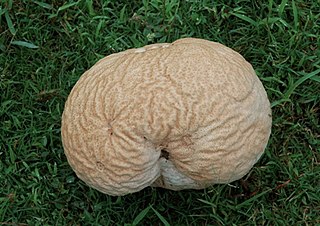
Calvatia is a genus of puffball mushrooms that includes the spectacular giant puffball C. gigantea. It was formerly classified within the now-obsolete order Lycoperdales, which, following a restructuring of fungal taxonomy brought about by molecular phylogeny, has been split; the puffballs, Calvatia spp. are now placed in the family Agaricaceae of the order Agaricales.

Irpex lacteus is a common crust fungus distributed throughout temperate areas of the world. It is the type of the genus Irpex. Irpex lacteus is considered a polypore, but depending on growth conditions it can also produce a hydnoid hymenophore. Due to this variability and abundance of the species it has been described as a new species to science numerous times and subsequently has an extensive synonymy. The complete genome sequence of Irpex lacteus was reported in 2017.
Trabutia is a genus of fungi in the family Phyllachoraceae.
Melanomma is a genus of fungi in the family Melanommataceae. It probably evolved from a lichen ancestor, as it is closely related to many lichenized species of fungi.

Venturia is a genus of fungi in the family Venturiaceae. First identified in 1882, species in the genus are plant pathogens. Venturia is widespread and the genus contains an estimated 58 species, or 130 species. Anamorphs were historically represented in the genus Fusicladium.
Seynesia is a genus of fungi in the family Cainiaceae.
Asterinella is a genus of fungi in the Microthyriaceae family. It is commonly found on decaying leaves or dead plants.
Microthyrium is a genus of fungi in the Microthyriaceae family.
Eriosphaeria is a genus of fungi in the family Trichosphaeriaceae. Species in this genus are plant pathogens.
Myriangium is a genus of fungi within the family Myriangiaceae.

Ustilaginoidea is a genus of fungi in the family Clavicipitaceae. The genus contains 19 species. Ustilaginoidea was circumscribed by German botanist Julius Oscar Brefeld in 1895, with Ustilaginoidea oryzae assigned as the type species. Ustilaginoidea virens causes the disesase known alternatively as rice false smut, pseudosmut, or green smut.

Isaria is a genus of fungi mostly in the order Hypocreales and family Clavicipitaceae, or by some authorities the Cordycipitaceae. It includes a large number of entomopathogenic species, some of them exploited as biopesticides : often previously assigned to the genus Paecilomyces.

Stilbella is a genus of fungi in the family Bionectriaceae. A 1985 monograph includes 19 species. More recent estimates place about 60 species in the genus. The type species Stilbella fimetaria(Pers.) Lindau 1905 has a cosmopolitan distribution and grows on herbivore dung. It has pink or orange slimy conidia on white synnemata with phialidic conidiogenous cells. Several species have since been reclassified in other genera based on DNA phylogenies or the discovery of sexual states, such as Atractium, Stilbocrea, and Trichoderma.





